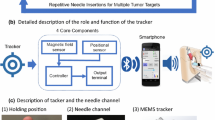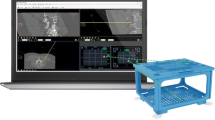Abstract
Purpose
Percutaneous punctures are often performed under computed tomography (CT) guidance using a freehand method. Especially in challenging cases, initial accuracy of the needle placement is highly dependent on the radiologist’s experience. Thus, a miniature lightweight guidance device was developed which is capable of assisting a radiologist during the needle placement process.
Methods
The device utilizes an accelerometer to measure the needle’s tilt by calculating a set of orientation angles. This set can be matched with the coordinate system of the CT imaging software during a simple alignment process. After that, the needle’s orientation can be expressed in terms of projected angles in the axial and sagittal planes. The accuracy of the device was evaluated in a phantom study, and initial clinical trials were carried out performing facet joint punctures in a swine cadaver.
Results
The sensor was embedded in a cube with dimensions of \(2\,\hbox {cm} \times 2\,\hbox {cm} \times 2\,\hbox {cm}\) and a total weight of about 11 g which can be attached to the puncture needle at its rear end or handgrip. A graphical user interface (GUÌ) has been created offering visual real-time orientation guidance. Results of the phantom experiments showed differences between planned target and performed puncture angles of \(0.96^{\circ } \pm 0.76^{\circ }\) for in-plane and \(1.78^{\circ } \pm 1.37^{\circ }\) for out-of-plane punctures.
Conclusion
The results of the phantom and ex vivo study suggest that the device is useful to assist a radiologist in CT-guided percutaneous punctures and helps navigating the needle with high precision.






Similar content being viewed by others
References
Hong CW, Xu S, Imbesi KL, Wood BJ (2013) Integrated laser-guided CT biopsy. Clin Imaging. doi:10.1016/j.clinimag.2013.08.006
Kirchner J, Kickuth R, Laufer U, Schilling EM, Adams S, Liermann D (2002) CT fluoroscopy-assisted puncture of thoracic and abdominal masses: a randomized trial. Clin Radiol 57(3):188–192. doi:10.1053/crad.2001.0716
Jacobi V, Thalhammer A, Kirchner J (1999) Value of a laser guidance system for CT interventions: a phantom study. Eur Radiol 9(1):137–140
Pereles FS, Baker M, Baldwin R, Krupinski E, Unger EC (1998) Accuracy of CT biopsy: laser guidance versus conventional freehand techniques. Acad Radiol 5(11):766–770
Cleary K, Peters TM (2010) Image-guided interventions: technology review and clinical applications. Annu Rev Biomed Eng 12:119–142. doi:10.1146/annurev-bioeng-070909-105249
Krombach GA, Schmitz-Rode T, Brabrand K, Meyer J, Wildberger JE, Wein BB, Gunther RW (2000) Initial experiences with a new optical target system (SimpliCT) for CT-guided punctures. RoFo : Fortschritte auf dem Gebiete der Rontgenstrahlen und der Nuklearmedizin 172(6):557–560. doi:10.1055/s-2000-3748
Schubert T, Jacob A, Pansini M, Liu D, Gutzeit A, Kos S (2012) CT-Guided Interventions using a free-hand, optical tracking system: initial clinical experience. Cardiovasc Intervent Radiol 1–8. doi:10.1007/s00270-012-0527-5
Penzkofer T, Bruners P, Isfort P, Schoth F, Gunther RW, Schmitz-Rode T, Mahnken AH (2011) Free-hand CT-based electromagnetically guided interventions: accuracy, efficiency and dose usage. Minim Invasive Ther Allied Technol 20(4):226–233. doi:10.3109/13645706.2011.553256
Moser C, Becker J, Deli M, Busch M, Boehme M, Groenemeyer DHW (2013) A novel laser navigation system reduces radiation exposure and improves accuracy and workflow of CT-guided spinal interventions: a prospective, randomized, controlled, clinical trial in comparison to conventional freehand puncture. Eur J Radiol 82(4):627–632. doi:10.1016/j.ejrad.2012.10.028
Yaniv Z, Wilson E, Lindisch D, Cleary K (2009) Electromagnetic tracking in the clinical environment. Med Phys 36(3):876–892
Luczak S, Oleksiuk W, Bodnicki M (2006) Sensing tilt with MEMS accelerometers. IEEE Sens J 6(6):1669–1675. doi:10.1109/JSEN.2006.881433
Grzeda V, Fichtinger G (2010) Rotational encoding of C-arm fluoroscope with tilt sensing accelerometer. In: Medical image computing and computer-assisted intervention: MICCAI international conference on medical image computing and computer-assisted intervention, vol 13(Pt 3), pp 424–431
Wolff T, Lasso A, Eblenkamp M, Wintermantel E, Fichtinger G (2014) C-arm angle measurement with accelerometer for brachytherapy: an accuracy study. Int J Comput Assist Radiol Surg 9(1):137–144. doi:10.1007/s11548-013-0918-3
Welch PD (1967) Use of fast Fourier transform for estimation of power spectra—a method based on time averaging over short modified periodograms. IEEE Trans Acoust Speech 15(2):70. doi:10.1109/Tau.1967.1161901
Joint Committee for Guides in Metrology-Working Group 1 (2008) Determining combined standard uncertainty. Evaluation of measurement data—guide to the expression of uncertainty in measurement. International Organization for Standardization, Geneva, Switzerland
Suh YS, Ro YS, Kang HJ (2012) Quaternion-based indirect Kalman filter discarding pitch and roll information contained in magnetic sensors. IEEE Trans Instrum Meas 61(6):1786–1792. doi:10.1109/Tim.2011.2181910
Roetenberg D, Slycke PJ, Veltink PH (2007) Ambulatory position and orientation tracking fusing magnetic and inertial sensing. IEEE Trans Biomed Eng 54(5):883–890. doi:10.1109/Tbme.2006.889184
Haid M, Breitenbach J (2004) Low cost inertial orientation tracking with Kalman filter. Appl Math Comput 153(2):567–575. doi:10.1016/S0096-3003(03)00656-8
Favre J, Jolles BM, Siegrist O, Aminian K (2006) Quaternion-based fusion of gyroscopes and accelerometers to improve 3D angle measurement. Electron Lett 42(11):612–614. doi:10.1049/El:20060124
Sabatini AM (2006) Quaternion-based extended Kalman filter for determining orientation by inertial and magnetic sensing. IEEE Trans Biomed Eng 53(7):1346–1356. doi:10.1109/TBME.2006.875664
Acknowledgments
The authors want to thank Elmar Junker and Joachim Pfeffer for their support in the hardware design and assembly process of the device.
Author information
Authors and Affiliations
Corresponding author
Rights and permissions
About this article
Cite this article
Wilkmann, C., Ito, N., Penzkofer, T. et al. A miniature accelerometer-based guidance device for percutaneous computed tomography-guided punctures. Int J CARS 10, 629–636 (2015). https://doi.org/10.1007/s11548-014-1096-7
Received:
Accepted:
Published:
Issue Date:
DOI: https://doi.org/10.1007/s11548-014-1096-7




